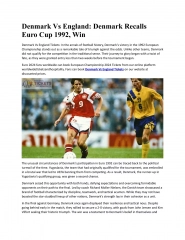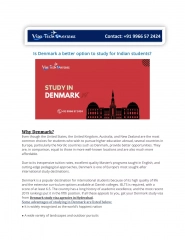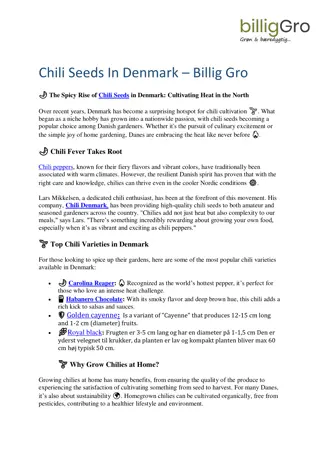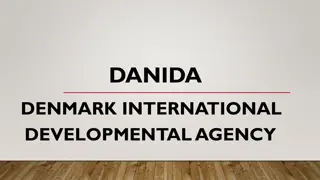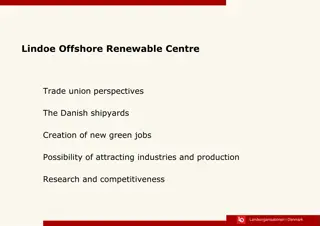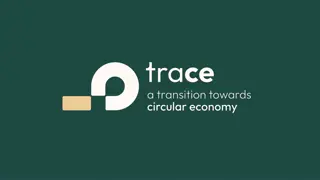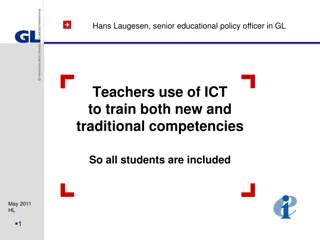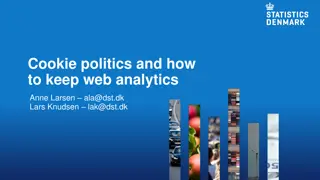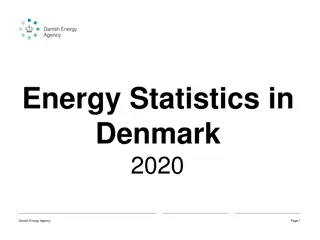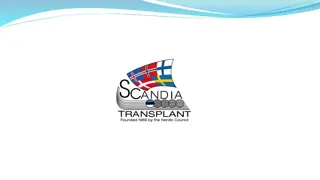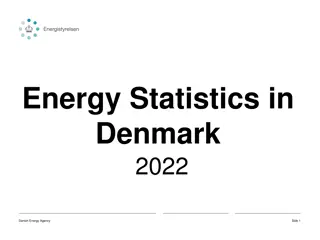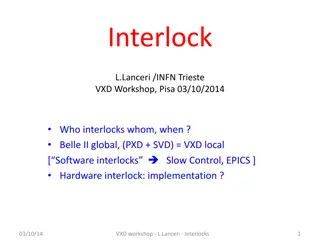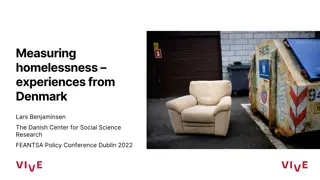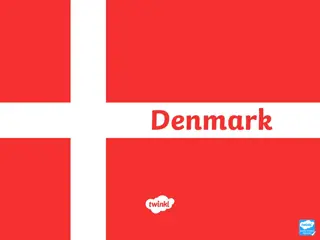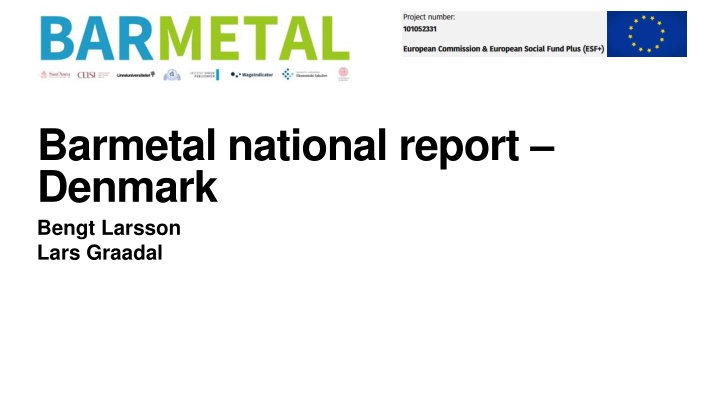
Industrial Relations and Policies in Denmark
Explore the industrial relations system and policies in Denmark, a small open economy with a strong welfare state and focus on digitalization and decarbonization. Discover the key features of Danish trade unions, collective bargaining, and social dialogue shaping the digitalization and automation dynamics in the country through insightful case studies.
Download Presentation

Please find below an Image/Link to download the presentation.
The content on the website is provided AS IS for your information and personal use only. It may not be sold, licensed, or shared on other websites without obtaining consent from the author. If you encounter any issues during the download, it is possible that the publisher has removed the file from their server.
You are allowed to download the files provided on this website for personal or commercial use, subject to the condition that they are used lawfully. All files are the property of their respective owners.
The content on the website is provided AS IS for your information and personal use only. It may not be sold, licensed, or shared on other websites without obtaining consent from the author.
E N D
Presentation Transcript
Barmetal national report Denmark Bengt Larsson Lars Graadal
1 + 2 Settings and Industrial relations syst. Denmark is a small open economy dependent on exporting industries. Many small companies : Pharmacy, machinery and food products are large sectors, metal is moderate and automotive is small= in the semi-periphery of Eur automotive ind (Pavlinek 2021). Around 10-11 % of Danish employees are in manufacturing (incl. mining), which is close to the EU-27 mean Denmark has a large welfare state based on social democratic traditions, however, as in other Nordic countries Denmark have seen the introduction of more liberal features, flexicurity , ie. easy to hire/fire, but generous benefits/access to education for unemployed. Danish trade unions are strong and are by tradition on an organized primarily on an occupational/industry basis, and previously three class-based confederations but Blue- and white collar confederations merged in 2019 into FH/Danish TU conf. TU density is 63% overall (58% in blue collar/private) some yellow unions . Collective bargaining coverage overall is 82% (priv sector 73%), appr 52% of enterprises have local union reps (single channel). Industrial relations characterized by strong trade unions and employer associations negotiating bipartite collective agreements at sectoral level with adj locally = strong autonomy from state, but some tripartite corporatism in employment policies and vocational training).
3 policies and social dialogue shaping DAD There is a very strong political and social partner commitment from Danish employers and unions regarding digitalization/automation, and also strong decarbonization ambitions to stay ahead in development and stay competitive General and sectoral collective agreements do not specifically regulate DAD, but, aspects such as further education/training, and H&S of course relates to this. Social partners cooperate on ed/training, and have a joint Technology and cooperation committee (TEKSAM), which: follow the technological development and support information, guidance and development work to promote cooperation in the companies, including the use of new technology (2020-23) + green transition is a central theme for TEKSAM in the coming years (2020-23)
4-5 DK CASE STUDIES Three company case studies and an additional interview with EO at sectoral level were used for the analysis. Company 1: produces catalysts for combustion engines, with appr. 2000 employees. (highly automated) Interviews with HR-manager, sustainability manager, shop floor worker Company 2. produces various things from atomatic luggage screening systems, to box systems for parcels (some automation) . Appr 400 employees in four plants. Interviews with HR- manager, Technical prod-Manager two shop stewards and a shop floor worker. Company 3. produces steel equipment for food industries. (low level of automation). Appr 100 employees. Interviews with Int CFO, HR- manager, shop steward and shop floor worker.
DK Company case studies: Digitalization/Automation All three companies use digital tech. in adm. Systems: finances, HR, and enterprise resource planning (ERP) systems, as well simple automation in production (Robotics/CNC machines). The two larger have digitalized customer relations, and more advanced robots, and both aim for AI-based automation in the future Main reasons for new technologies are straightforward: increasing productivity, cost efficiency and business expantion.. Robots/automation is also to increase quality, and improve production flow and replace/release workers from monotonous tasks Additional driving forces are requirements from customers, and in lower-level bottom-up improvements suggestions from the employees. Only in the largest company did local TU have a consultative role: BUT employees had some influence on implementation because of experiences of failed implementation previously Just as on sectoral level, local level TU reps seem to agree on the need for automation Further education/training is the big local issue: send out their own knowledgeable workers + bring in education from the tech-supplier + one company finance external further education for 12 employees/year too top up their education/training as blacksmiths/technicians etc.
DK Company case studies: Decarbonization Decarbonization is less developed in the companies The largest one (#1) has a formal sustainability policy since 2021. The smallest started its journey by completing its first Climate Report two weeks prior to the interview. The companies are still only in their start-up process in relation to decarbonization, but: Company #1 producing catalyst have started producing a Fuel cell to adapt to the decarbonization of vehicles. Company #2, introduction of new more energy effective machinery and a planned installation of solar cells later this year Company #3, have started to discuss both new machinery and solar cells.
6. Comparative: similar countries = DK+SE DISSIMILAR: Automotive still large in SE, marginal in DK Company sizes generally larger in SE as compared to DK SIMILAR: employer and union consensus in the need for further DAD DISSIMILAR less discussion of risks for employees/jobs in by Danish Tus as compared to Sweden: In Denmark D+A is thought to both keep/bring home plants/jobs and improve working conditions by reducing heavy and monotonous tasks. SIMILAR: Decarbonization is thought to create jobs and improve competitiveness and it is very much seen as part of the digitalization development SIMILAR:. joint social partner cooperation on DAD is thought to benefit both companies, and employees and strengthen economic development SIMILAR: DAD not specifically regulated in CAs (Sectoral level most important). BUT Education/training + H&S in CA are relevant in relation to DAD-consequences and both are regulated sectorally, and often well-developed locally in both countries.
7. Comparative: Dissimilar countries DK/SE vs: HU/RS Sorry if misrepresenting, and/or deemphasising exceptions! DISSIMILAR: DK+ SE strong Bipartite SO relations (UD+CA) at central, sectoral and union presence/dialogue at local level HU/RS weaker SP relations (some of Tripartite), particularly at Sectoral level (in metal), low union prescense at local level (though WCs), but Cas in some/large comp. DK/SE strong commitment to DAD at both policy and in SP-cooperation/policy: HU/RS strong Digitalization agenda nationally, HU Weak Decarbonization agenda (RS stronger), and weak D-A-D engagement (by social partners) in social dialogue. SIMILAR: More of DA than Decarbonization efforts in companies Training/retraining offered (in some/big companies) also assisted by suppliers/other org. (Different: In SE/DK also regulated by CA) otherwise DAD outside of SD/CA Local union presence/ some consultation in case-companies, but not about DAD. Some employee influence in implementation of tech.


